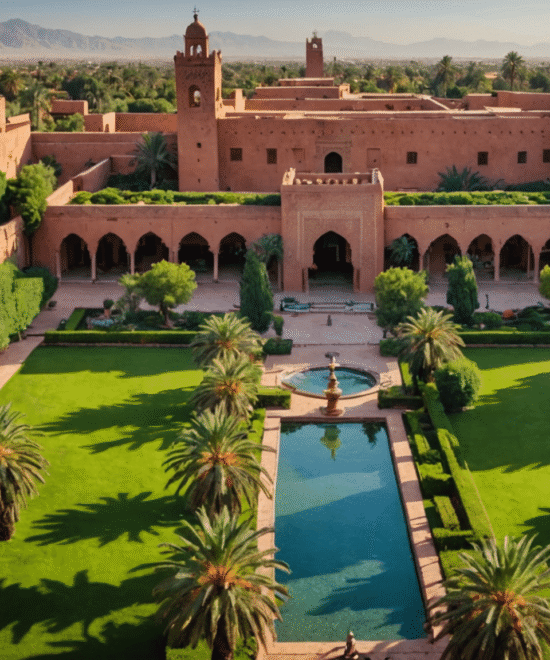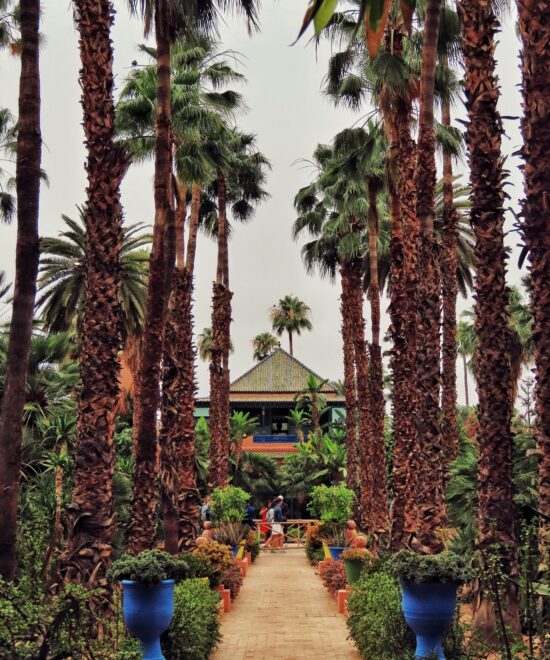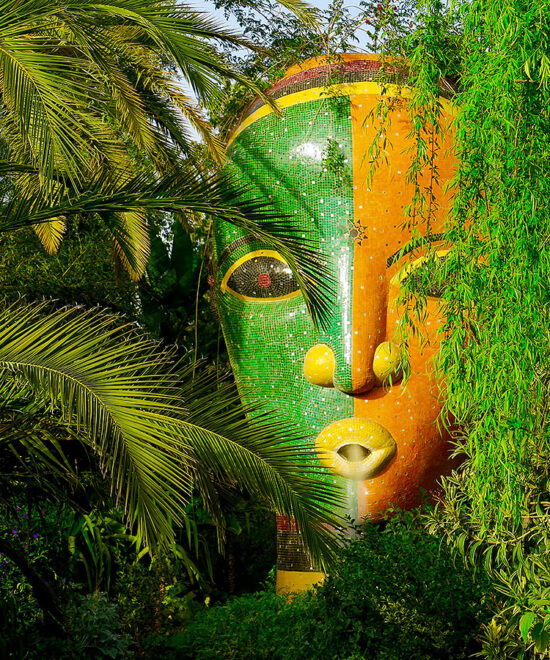- Marrakech , Morocco
- Hi@darstay.com

🌿 Jardin Majorelle
Perhaps the most famous of Marrakech’s gardens, Jardin Majorelle is more than just a botanical paradise — it’s a cultural landmark. Created in the 1920s by French painter Jacques Majorelle, the garden was later restored by Yves Saint Laurent and Pierre Bergé, who saved it from ruin and transformed it into one of Morocco’s most beloved sites.
More than just a garden, this iconic site is a masterpiece of art and culture, where history, design, and botany come together in a way that continues to captivate travelers from around the world. Whether you are passionate about art, fascinated by Moroccan history, or simply looking for a tranquil oasis amidst Marrakech’s energy, Jardin Majorelle is an unmissable experience.
What makes this garden unforgettable is the dazzling Majorelle Blue, a deep cobalt hue that contrasts with exotic plants from five continents. Bamboo groves, cactus-lined alleys, fountains, and lily ponds create a dreamlike atmosphere where every corner invites discovery.
Inside the grounds, visitors will also find the Berber Museum, celebrating Morocco’s indigenous heritage through jewelry, textiles, and traditional artifacts. A stroll through Jardin Majorelle is not just a nature walk — it’s an immersion in Moroccan art, history, and identity.


🎨 The Origins: Jacques Majorelle’s Vision
The story of Jardin Majorelle begins in the 1920s, when French painter Jacques Majorelle fell under the spell of Marrakech. Captivated by the city’s light, colors, and exotic atmosphere, Majorelle purchased land just outside the old city walls and began creating his own botanical garden.
For nearly four decades, Majorelle dedicated himself to cultivating this garden, importing plants from across the globe — bamboo, palms, cacti, bougainvillea, jasmine, and more. The result was a living canvas where he could blend his love of art and nature.
Perhaps his most enduring contribution was the creation of “Majorelle Blue”, a striking cobalt hue inspired by Moroccan tiles and desert skies. This bold color, applied to walls, fountains, and pathways, became the garden’s signature and remains one of its most photographed features today.
🌟 The Yves Saint Laurent & Pierre Bergé Era
By the 1960s, after Jacques Majorelle’s death, the garden had fallen into neglect. It was then that two visionary figures — Yves Saint Laurent and Pierre Bergé — discovered the space during one of their stays in Marrakech. Struck by its beauty and potential, they purchased and restored Jardin Majorelle in the 1980s, saving it from destruction.
Under their care, the garden was meticulously revived, its plant collection expanded, and its artistic spirit preserved. Yves Saint Laurent, who often described Marrakech as his source of inspiration, credited the city — and the garden in particular — for influencing his most iconic designs.
Following Yves Saint Laurent’s passing in 2008, his ashes were scattered in the garden’s memorial. Today, a memorial monument and a museum dedicated to his work stand nearby, ensuring his deep connection with Marrakech remains eternal.
🌿 A Living Botanical Masterpiece
Walking through Jardin Majorelle is like stepping into a dream. The gardens span nearly 2.5 acres, with winding pathways leading you through a kaleidoscope of plant life. More than 300 species from five continents coexist in harmony:
Towering bamboo groves whispering in the breeze.
Majestic palms and coconut trees providing shade.
Exotic cacti forming surreal landscapes.
Vibrant bougainvillea climbing across walls and trellises.
Lilies and lotus flowers gracing tranquil ponds.
Every corner reveals a carefully curated scene, enhanced by the bold contrast of Majorelle Blue against golden yellows, terracotta reds, and lush greens. For photographers and Instagram enthusiasts, it is one of the most visually striking places in all of Marrakech.

🏛️ The Berber Museum
Beyond its natural beauty, Jardin Majorelle also offers cultural depth. Inside the garden is the Berber Museum, housed in the former painting studio of Jacques Majorelle.
The museum presents a carefully curated collection of artifacts that celebrate the history, traditions, and artistry of Morocco’s Berber (Amazigh) people — the country’s original inhabitants. Jewelry, textiles, ceremonial objects, and ancient tools provide fascinating insight into their enduring culture, making the museum a highlight for history lovers.
📸 Why Jardin Majorelle is a Must-Visit in Marrakech
Art & Nature in Harmony: Few places in the world merge artistic vision with botanical wonder so seamlessly.
An Instagram Icon: Its cobalt blue walls and exotic plants make it one of the most photographed spots in Morocco.
Cultural Significance: From Jacques Majorelle to Yves Saint Laurent, the garden has inspired generations of creators.
Tranquility Amidst Chaos: In a city as energetic as Marrakech, Jardin Majorelle provides a rare and peaceful escape.
🕒 Visitor Information
Opening Hours: Open daily, usually from 8:00 AM to 6:00 PM (hours may vary slightly by season).
Location: Rue Yves Saint Laurent, just outside Marrakech’s Medina.
Tickets: Separate tickets are required for the garden, the Berber Museum, and the Yves Saint Laurent Museum nearby.
Best Time to Visit: Early morning or late afternoon for fewer crowds and softer light for photography.
✨ Conclusion: A Timeless Jewel of Marrakech
Jardin Majorelle is far more than a tourist attraction — it’s a symbol of Marrakech’s creative spirit. From Jacques Majorelle’s original vision to Yves Saint Laurent’s passionate restoration, the garden embodies the city’s ability to inspire, reinvent, and enchant.
For travelers, it offers a rare chance to experience Marrakech not just as a place of history, but as a living, breathing work of art. Whether you’re an art lover, a photographer, or simply someone in search of beauty and calm, Jardin Majorelle will leave a lasting impression.
So on your next stay with DARSTAY, don’t miss the opportunity to wander through this iconic oasis — where color, culture, and nature come alive.



